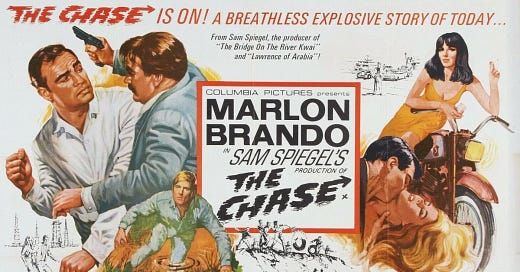Every year I try and bring either an actor or a director in focus, sort of as an anchor or a center point for my movie watching through the months. One year it was John Wayne, another was Gregory Peck, and this year I am setting my sights on the expansive career of Robert Redford.
Several of his movies I have seen, and will look at again, along with several more I have not yet seen. This will not be comprehensive, as made clear by this very first entry which skips over three films, but it will be an attempt to gain a clearer picture of who Redford was, who he became, and where he stands now in the annals of film history.
The Chase (1966)
Arthur Penn’s The Chase has very little in the way of chases. What begins as an escaped-convict manhunt quickly settles into something much more languid and thematically rich than traditionally exciting. The real chasing going on here lies within every character as they chase love, acceptance, and identity in a Texas town on the verge of seismic cultural changes in the late 1960s.
The escaped convict, the catalyst of the story, is Robert Redford’s Bubber Reeves. He and another prisoner escape, but Reeves’s partner soon kills a man and takes his car, leaving Reeves to fend for himself and, ultimately, make his way back to Tarl County where his lonely wife, Anna, (Jane Fonda) has fallen into an affair with Jake (James Fox).
Fonda’s Anna is not the only one waiting on Bubber’s return. All the citizens are in a tizzy about the possibility of Bubba Reeves making his way back, and they want Sheriff Calder (Marlon Brando) to do something about it. Calder, however, believes Reeves to be innocent of his crimes, and his pursuit is anything but hot.
The plot is much more convoluted than this simple layout, as it delves into the infidelities and secrets of the people occupying this town. A great deal of the second act - honestly too much time - is dedicated to a party the citizens throw while waiting on Bubber to return. Infidelities and dishonesty surface and create a pallor of anxiety and mistrust as anticipation brings out the worst of everyone. In this regard, The Chase is much more a Tennessee Williams play, or a precursor to something like The Last Picture Show, where secrets are exposed and lonely lovers lash out.
There are many different avenues to explore when it comes to the thematic DNA of The Chase. Not only is it about the anxiety of Bubber coming back and possibly upending the shaky foundation of this town with his secrets, it is about men struggling to deal with the women in their lives as the late sixties bring about great cultural change. The suburbs, idyllic in the fifties as they were born from post-war prosperity, have begun to decay by 1966. Housewives were pushing for agency, and the performances from Fonda’s Anna or Janice Rule’s defiant, lustful Emily, or even Angie Dickinson’s dutiful wife to Brando’s Sheriff Calder echo the sentiment of the time. Of course the men, like Robert Duvall’s cuck husband Edwin, are struggling to get a handle on these free spirits. At the same time, racial integration is on the cusp of a breakthrough, and the looming Civil Rights Movement of 1968 is felt creeping into the social fabric of this town, especially in one scene where an innocent black man is accused of trying to sneak into a white woman’s apartment.
No one is really the star of The Chase, as we spend a great deal of time with a wide swath of the townsfolk. One could argue it is Brando’s film, but even he disappears for long stretches of time. Redford is physically absent from most of the first two acts, but the very idea of his presence is the catalyst for the entire story. He hangs over everything. That is why someone as handsome as Redford is perfect for the role. Bubber Reeves must not only be innocent of his crimes, but he must be alluring and intoxicating in a way.
This was only Redford’s third major role. He was chosen by producer Sam Spiegel after he saw the women in the studio offices reacting to Redford’s mere presence. The film itself is generally forgotten these days, due in large part to the sensation that was Penn’s next film, Bonnie and Clyde, which has echoes of the scenery and the rich cinematography here. This is no Bonnie and Clyde, but it may be worth your time just to see the fresh faces of an upcoming generation of stars.




